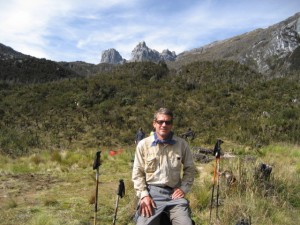By Gail Wood
 To gain access to this elite club, he survived minus 67-degree temperatures climbing Mount Vinson, an icy 16,050-foot peak in Antarctica.
To gain access to this elite club, he survived minus 67-degree temperatures climbing Mount Vinson, an icy 16,050-foot peak in Antarctica.
He endured 100-mile-per-hour winds on Mount McKinley.
And he survived a fall near the summit of Mount Everest, just before approaching Hillary Step.
Steve Giesecke, who hiked in the Olympics as a kid with his father while growing up in Olympia, has climbed the seven tallest peaks on the seven continents. That earns him membership to a select club.
“I have an immense sense of gratitude about the whole thing,” Giesecke said. “I was pretty driven for a while to be honest about it.”

In January 2011, Giesecke climbed the last of his seven peaks, ascending Antarctica’s Mount Vinson despite extreme cold, hard winds and threats of frostbit. At that time, only 86 Americans and fewer than 280 people worldwide had climbed all seven peaks.
Giesecke’s first of seven peaks was McKinley, which is now also referred to as Denali. While in the Air Force and stationed in Alaska, he climbed the 22,320-foot mountain in 1989, convincing his guide to labor on despite hurricane-like winds. He was just one of two in his eight-man party to summit McKinley that day. Seven years earlier he had climbed Mount Rainier for the first of 13 times.
Giesecke celebrated his 35th birthday hunkered down on the side of McKinley, riding out a storm. At the time, he had no idea he was going to climb the seven summits. He remembers talking on the radio with a climbing party higher up on the mountain, hunkered in their tent as 100-mph winds blew.
“Their tent was blown off the mountain,” Giesecke said. “And it was cold. We almost didn’t summit.”
It wasn’t until 18 years later that Giesecke began thinking about attempting the Seven Summits.
He moved back to Olympia in 2001 after retiring from the Air Force as a colonel. He then got involved with the Mountaineers and climbed Rainier and began looking for a bigger challenge.
Then in his early 50s, Giesecke began pondering the Seven Summit challenge.

“I thought about going to go down to Aconcagua in South America,” Giesecke said.
The second of seven peaks Giesecke climbed was Aconcagua, a 22,838-foot peak in South America’s Andes. It’s the tallest mountain in the world outside of the Himalayas. If that climb went well, Giesecke decided he’d head immediately to Everest. Giesecke was again one of two climbers in his group to summit Aconcagua, convincing him Everest was next.
After returning to Olympia for a month, long enough to get his passport problem settled, Giesecke flew to Nepal. Climbing Aconcagua helped Giesecke acclimate to Everest’s high altitudes. Base camp on Everest is at nearly 18,000 feet, almost 4,000 feet taller than Rainier.
“By spending time at base camp, that optimizes your body’s ability to process oxygen by increasing your red blood cell count,” Giesecke said. “If you and I went to the summit of Everest right now, we’d be unconscious in less than 30 minutes.”
There’s just not enough oxygen.
As Giesecke neared the summit of Everest, he slowly made his way across the Cornice Traverse, a razor-blade ridge just before Hillary’s Step. Following the narrow path, Giesecke’s boot broke through the side of the icy cornice and he fell 20 feet. Fortunately, he was hooked to a fixed safety line and his rope pulled taunt, holding him and preventing him from falling 6,000 feet to his death.
Carefully, Giesecke got back onto the trail and resumed the climb to the summit. He said his emotional response was pretty sedate because of fatigue.

“You’ve been up for about two days,” he said. “Your body is just shedding weight like crazy. You’re pretty depleted.”
On that final day, Giesecke said he burned about 20,000 calories and lost about 20 pounds.
“You’re not taking anything in and it’s very strenuous,” Giesecke said. “You’re tired. But it’s balanced with some euphoria being on the top of the world.”
In four years, from 2007 to 2011, Giesecke climbed six of the seven peaks, earning him membership into a special club and giving him a sense of relief. He was glad to be on the top of Mount Vinson, knowing his quest was over.
“I just felt so relieved,” he said. “It was over.”
After Everest, Giesecke climbed in 2008 Mount Elbrus in Russia along the Caucasus Mountain Range where the next winter Olympics will be held. From Russia, Giesecke flew to Africa to hike up Kilimanjaro, a 19,341-foot peak. At that point, Giesecke wasn’t sure he’d climb the next two mountains – Carstensz Pyramid in Indonesia and Mount Vinson in Antarctica.
“The last two are so hard to get to and so very expensive,” said Giesecke, who figured he spent about $100,000 on all seven climbs. “So, I didn’t know if I’d finish.”
Then Julie Smith, a fellow Mountaineer who was also attempting the seven summits, called Giesecke and said “Lets go.” That was 2010.
“It was the push I needed,” Giesecke said.





















































